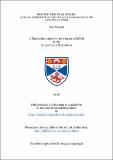Files in this item
Beyond the pale horse : animals, substitution, and the cost of romance in the 'Orlando furioso'
Item metadata
| dc.contributor.advisor | Davis, Alex | |
| dc.contributor.author | Grogan, Tess | |
| dc.coverage.spatial | vi, 135 p. | en_US |
| dc.date.accessioned | 2018-12-03T11:05:03Z | |
| dc.date.available | 2018-12-03T11:05:03Z | |
| dc.date.issued | 2018-06-26 | |
| dc.identifier.uri | https://hdl.handle.net/10023/16609 | |
| dc.description.abstract | This study responds to Patricia Parker's landmark account of endlessly expansive romance, suggesting that the genre's structural deferrals and excesses come at a steep hidden price. Like other early modern discourses—rhetoric, economics, empiricism—romance produces a fiction of unmitigated progress which assiduously obscures losses sustained along the way. Ludovico Ariosto's ‘Orlando furioso’ is distinct from later romance epics because it refuses to conceal its own logic, instead staging scenes of cost openly and conspicuously. I suggest that the brutal subroutines sustaining romance's narrative profusion are visible in the poem's exceptionally strange and vital animal figures, which deviate sharply from more conventional images deployed by Ariosto's successors. The first chapter considers the figure of the mother predator, whose irate defense of her abducted offspring serves to augment the wrath of the Furioso's male paladins. These indecorous comparisons destabilize the poem's justifications for violence; by contrast, similar figures in Edmund Spenser's ‘The Faerie Queene’ and Torquato Tasso's ‘Gerusalemme liberata’ reinforce normative hierarchies and place romance's violence beyond question. The second chapter addresses Orlando's savage killing of a female packhorse while in the nadir of his madness. With reference to the poem's other scenes of sexualized violence, I respond to readings that situate Ariosto's mare as a symbol of humanist dialectic advancement, suggesting that the mare's adamant suffering instead exposes the costs exacted by that romance of progress, a disclosure which disappears in the later poems. The stakes of this project are urgent: by attending to the ways in which romance linchpins arme and amori are mapped onto women and female animals, it is possible to trace how sexual violence was understood by a poem with a broad and enduring legacy, and to approach its disclosures as a radical act. | en_US |
| dc.language.iso | en | en_US |
| dc.publisher | University of St Andrews | |
| dc.subject | Romance epic | en_US |
| dc.subject | Gender | en_US |
| dc.subject | Animal | en_US |
| dc.subject | Violence | en_US |
| dc.subject | Renaissance | en_US |
| dc.subject.lcc | PQ4570.G8 | |
| dc.subject.lcsh | Ariosto, Lodovico, 1474-1533. Orlando furioso | |
| dc.subject.lcsh | Epic literature, Romance-language--History and criticism | en |
| dc.subject.lcsh | Romances--History and criticism | en |
| dc.subject.lcsh | Violence in literature | en |
| dc.subject.lcsh | Animals in literature | en |
| dc.subject.lcsh | Sex in literature | en |
| dc.title | Beyond the pale horse : animals, substitution, and the cost of romance in the 'Orlando furioso' | en_US |
| dc.type | Thesis | en_US |
| dc.contributor.sponsor | Great Britain. Marshall Aid Commemoration Commission | en_US |
| dc.type.qualificationlevel | Masters | en_US |
| dc.type.qualificationname | MPhil Master of Philosophy | en_US |
| dc.publisher.institution | The University of St Andrews | en_US |
| dc.identifier.doi | https://doi.org/10.17630/10023-16609 |
This item appears in the following Collection(s)
Items in the St Andrews Research Repository are protected by copyright, with all rights reserved, unless otherwise indicated.

